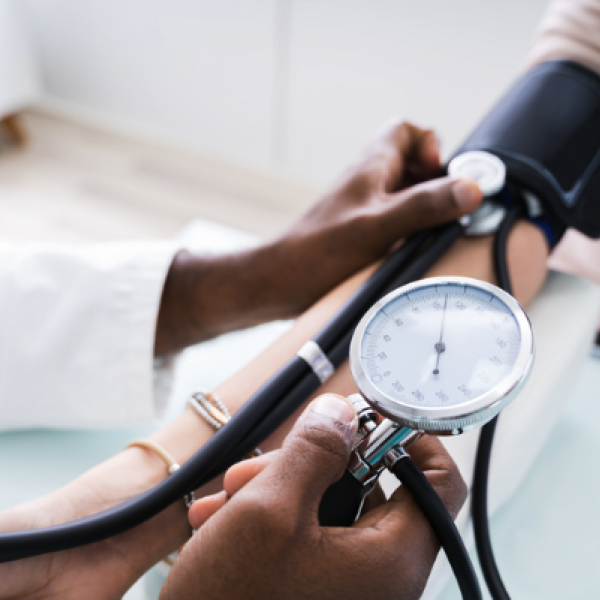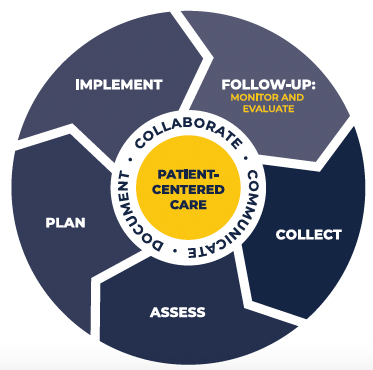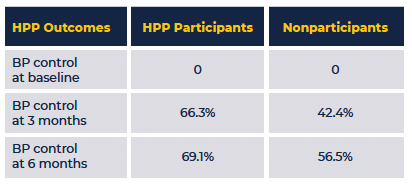Case Study: Hypertension Improved by 66% in Three Months with Pharmacist-Centric Care Model
February 27, 2024
By: Toni Shears, Lindsay Groth
 Overview
Overview
Hypertension is a silent, often symptom-free condition affecting an estimated 47% of adults, or nearly 120 million people, in the United States.
Only about a quarter of those patients diagnosed with hypertension have their blood pressure under control (130/80 mm/Hg or less), according to the CDC.2 Uncontrolled blood pressure is a serious risk factor, and it is closely linked to stroke and heart disease, two of the leading causes of death in the United States (U.S.)
Problem
With uncontrolled hypertension, there is a risk of death and disability due to cardiovascular disease. This chronic condition can be managed by medication, lifestyle factors such as improved diet and exercise, or a combination of both. Hae Mi Choe, Associate Dean for Pharmacy Innovations and Partnerships at the College of Pharmacy and Chief Population Health Officer for University of Michigan Health, recognized that Pharmacists could play a role in the solution.

Solution
Creating a Pharmacist-Centric Care Model
In 1999, Dr. Choe, recognized that to improve the management of chronic conditions like hypertension, prescribed treatments should be paired with patient education, counseling, and follow-up visits to ensure that patients understand the importance of adhering to their care plan.
Knowing that patient education is at the core of a pharmacist’s role, Dr. Choe and her team created a new pharmacist-centric care model to try to improve patients’ control of their blood pressure and test the effectiveness of this approach. In the program they created, the pharmacist:
- Is embedded in the care team and specially trained.
- Provides education and consultation to their patients.
- Follows up with patients to monitor lifestyle changes and the effectiveness of the drugs.
- Adjusts therapeutic regimen to improve patient outcomes in coordination with the physicians.
Program Launch and Expansion of the HypertensionPharmacist Program (HPP)
- Dr. Choe launched the program in one ambulatory care clinic at East Ann Arbor Health Center in Michigan and continued to expand into all primary care clinics at U-M Health.
- Recognizing that for patients to get to their primary care clinic for counseling and follow-ups to monitor their condition may not be convenient (or possible) on a regular basis. HPP partnered with Meijer, a Michigan-based chain of superstores. Its pharmacists went through special training to provide the same customized consultation by appointment in stores. The partnership expanded to encompass five participating stores that offer 52 consultation appointments per week.
Results
HPP grew to include all of U-M Health’s 14 primary care clinics. Analysis showed that the program was highly effective.
Outcomes Evaluation and Expansion of HPP by Centers for Disease Control and Prevention (CDC)
In 2023, the Centers for Disease Control and Prevention (CDC), seeking proven patient-centered models of care that help patients better control their hypertension, selected HPP as a potential model to replicate. The CDC’s Division for Heart Disease and Stroke Prevention conducted a thorough evaluation of the program and showed that providing pharmacist-based consultations and follow-up helped participating patients achieve and maintain control of their blood pressure:
In addition, the CDC evaluation showcased that HPP:
- Improved medication management and patients benefited from more frequent adjustments than those not in the program.
- Participants had fewer visits to their primary care physician.

As a result of these findings, the CDC highlighted the HPP as an effective model and published a detailed implementation guide to support and encourage other health systems to replicate the University of Michigan Health approach.
CDC Piloting the Model to Reach Underserved Populations.
Based on the success of HPP, the CDC is replicating and scaling the program to reach underserved patient communities in the southeastern U.S., and sought nominations of healthcare systems serving primarily African American patients. Initially, one will be selected for implementation of the HPP model, with training and partial financial support.
HPP in the State of Michigan
The program continues to expand based on the demand for services, which include increasing available hours for follow-up at the clinics and community pharmacies. What’s even more exciting is that Dr. Choe is looking to expand community pharmacy partnerships into other disease states based on the positive outcomes with hypertension.
Download Case Study PDF
Sources
- Centers for Disease Control and Prevention. Estimated Hypertension Prevalence, Treatment, and Control Among U.S. Adults. Million Hearts: https://millionhearts.hhs.gov/data-reports/hypertension-prevalence.html, accessed 8 Jan. 2024.
- Centers for Disease Control and Prevention. Hypertension Cascade: Hypertension Prevalence, Treatment and Control Estimates Among U.S. Adults Aged 18 Years and Older Applying the Criteria From the American College of Cardiology and American Heart Association’s 2017 Hypertension Guideline—NHANES 2015–2018. Atlanta, GA: U.S. Department of Health and Human Services; 2021.
Most Recent Stories
PharmD Alum Takes Medication Expertise to the Boardroom
February 27, 2025
His ability to understand each new pharmaceutical is a skill he developed during his time in U-M’s PharmD program – where the curriculum focuses on problem-solving, critical thinking, leadership, research and the utilization of skills to practice as a pharmacist in any setting.
Masters Alum Combines Passion for Pharmacy and Health Economics & Outcomes Research
February 14, 2025
Devyani Bhatnagar, MS, combined her passions for pharmacy and health economics by pursuing a Masters of Science in Integrated Pharmaceutical Sciences, where she crafted a personalized academic path and conducted impactful research on opioid use.
We Are Phamily
February 7, 2025
Their story starts far before they were hailing “Go Blue” at the Big House and staying up late to cram for their medicinal chemistry final in PharmD school.